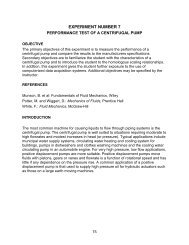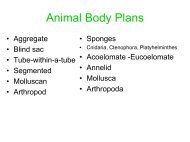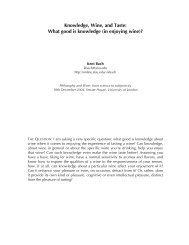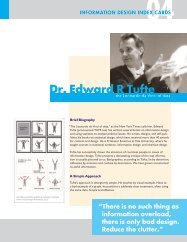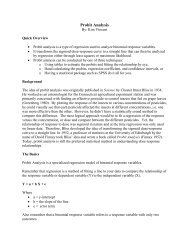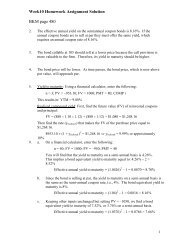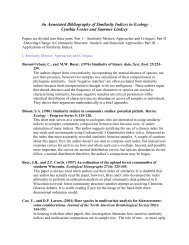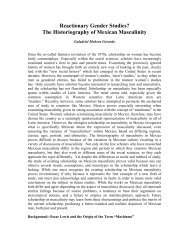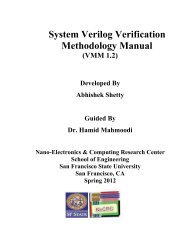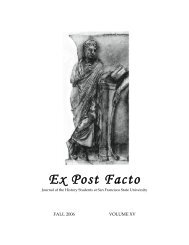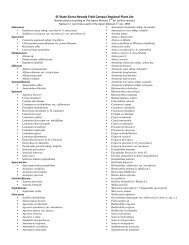Molecular Phylogeny of the Chipmunks Inferred from Mitochondrial ...
Molecular Phylogeny of the Chipmunks Inferred from Mitochondrial ...
Molecular Phylogeny of the Chipmunks Inferred from Mitochondrial ...
You also want an ePaper? Increase the reach of your titles
YUMPU automatically turns print PDFs into web optimized ePapers that Google loves.
<strong>Molecular</strong> Phylogenetics and Evolution<br />
Vol. 20, No. 3, September, pp. 335–350, 2001<br />
doi:10.1006/mpev.2001.0975, available online at http://www.idealibrary.com on<br />
<strong>Molecular</strong> <strong>Phylogeny</strong> <strong>of</strong> <strong>the</strong> <strong>Chipmunks</strong> <strong>Inferred</strong> <strong>from</strong><br />
<strong>Mitochondrial</strong> Cytochrome b and Cytochrome Oxidase II<br />
Gene Sequences<br />
Antoinette J. Piaggio and Greg S. Spicer<br />
Department <strong>of</strong> Biology, San Francisco State University, 1600 Holloway Avenue, San Francisco, California 94132<br />
There are currently 25 recognized species <strong>of</strong> <strong>the</strong><br />
chipmunk genus Tamias. In this study we sequenced<br />
<strong>the</strong> complete mitochondrial cytochrome b (cyt b) gene<br />
<strong>of</strong> 23 Tamias species. We analyzed <strong>the</strong> cyt b sequence<br />
and <strong>the</strong>n analyzed a combined data set <strong>of</strong> cyt b along<br />
with a previous data set <strong>of</strong> cytochrome oxidase subunit<br />
II (COII) sequence. Maximum-likelihood was used<br />
to fur<strong>the</strong>r test <strong>the</strong> fit <strong>of</strong> models <strong>of</strong> evolution to <strong>the</strong> cyt<br />
b data. O<strong>the</strong>r sciurid cyt b sequence was added to<br />
examine <strong>the</strong> evolution <strong>of</strong> Tamias in <strong>the</strong> context <strong>of</strong><br />
o<strong>the</strong>r sciurids. Relationships among Tamias species<br />
are discussed, particularly <strong>the</strong> possibility <strong>of</strong> a current<br />
sorting event among taxa <strong>of</strong> <strong>the</strong> southwestern United<br />
States and <strong>the</strong> extreme divergences among <strong>the</strong> three<br />
subgenera (Neotamias, Eutamias, and Tamias). © 2001<br />
Academic Press<br />
Key Words: Tamias; Eutamias; Neotamias; molecular<br />
evolution; phylogenetics; mitochondrial DNA; cytochrome<br />
b; cytochrome oxidase subunit II; maximumlikelihood,<br />
molecular clock.<br />
INTRODUCTION<br />
Chipmunk systematics has been elucidated by means<br />
<strong>of</strong> morphological, karyotypic, immunological, and host–<br />
parasite data sets. There have been diverse attempts to<br />
determine <strong>the</strong> patterns <strong>of</strong> evolution, dispersal, and relatedness<br />
among <strong>the</strong>se taxa. The different data sets have<br />
generated varying conclusions about <strong>the</strong> systematics <strong>of</strong><br />
chipmunks, ranging <strong>from</strong> <strong>the</strong> currently recognized single<br />
genus (Tamias) with three subgenera, to previous designations<br />
that included two separate genera with one genus<br />
being fur<strong>the</strong>r subdivided into two subgenera, to <strong>the</strong><br />
designation <strong>of</strong> three separate genera (Tamias, Neotamias,<br />
and Eutamias) for all chipmunk species (Allen,<br />
1891; Howell, 1929; Ellerman, 1940; White, 1953a;<br />
Nadler, 1964; Nadler et al., 1969, 1977, 1985; Ellis and<br />
Maxson, 1979; Hafner, 1984; Levenson et al., 1985; Jameson,<br />
1999). We investigated <strong>the</strong> taxonomy <strong>of</strong> this group by<br />
generating a molecular phylogeny based on mitochondrial<br />
DNA (mtDNA).<br />
Received March 9, 2000; revised March 13, 2001<br />
335<br />
Chipmunk species have a remarkable geographical<br />
distribution. Tamias sibiricus (subgenus Eutamias) occurs<br />
in Asia, T. striatus (subgenus Tamias) occurs<br />
throughout <strong>the</strong> eastern United States, and <strong>the</strong> remaining<br />
23 species (subgenus Neotamias) are distributed<br />
throughout <strong>the</strong> western United States and Mexico. The<br />
distribution <strong>of</strong> Tamias has led many authors to hypo<strong>the</strong>size<br />
many possible evolutionary events that might<br />
have produced this distribution. However, <strong>the</strong> origin <strong>of</strong><br />
<strong>the</strong> ancestral stock is not agreed upon, and we will<br />
argue that it is not important for a discussion <strong>of</strong> <strong>the</strong><br />
taxonomy <strong>of</strong> <strong>the</strong>se taxa.<br />
The purpose <strong>of</strong> this study was to explore <strong>the</strong> evolution<br />
and systematics <strong>of</strong> <strong>the</strong> genus Tamias as inferred<br />
<strong>from</strong> <strong>the</strong> complete mitochondrial sequences <strong>of</strong> <strong>the</strong> cytochrome<br />
b (cyt b) gene. In addition, we combined cyt b<br />
sequence with cytochrome oxidase subunit II (COII)<br />
gene sequences <strong>from</strong> an earlier study (Piaggio and<br />
Spicer, 2000). The gene phylogenies <strong>of</strong> COII and cyt b<br />
were evaluated separately and in combination. We inferred<br />
a molecular phylogeny <strong>from</strong> <strong>the</strong> combined data<br />
to determine whe<strong>the</strong>r <strong>the</strong>re was a geographic correlation<br />
to <strong>the</strong> clades on <strong>the</strong> tree. The cyt b data set includes<br />
more taxa than did our previous COII data set.<br />
Indeed, <strong>the</strong> cyt b phylogeny revealed unexpected relationships<br />
and recent speciation events. Therefore, we<br />
discuss <strong>the</strong> taxonomy <strong>of</strong> <strong>the</strong> additional taxa based on<br />
our cyt b molecular phylogeny and in <strong>the</strong> context <strong>of</strong><br />
previous morphological analyses. Finally, we use <strong>the</strong><br />
cyt b tree to examine <strong>the</strong> taxonomic relationships<br />
among species in <strong>the</strong> subgenus Neotamias. Neotamias<br />
represents taxa that have undergone extensive radiation<br />
and differentiation across <strong>the</strong> western United<br />
States. The taxonomic relationships inferred <strong>from</strong> <strong>the</strong><br />
Neotamias clade provide resolution to previous debates<br />
on <strong>the</strong> taxonomy <strong>of</strong> many species within this group.<br />
METHODS AND MATERIALS<br />
Specimens. Forty-eight specimens representing 23<br />
<strong>of</strong> <strong>the</strong> 25 currently recognized species in <strong>the</strong> genus<br />
Tamias (Levenson et al., 1985) and <strong>the</strong> outgroup taxon<br />
1055-7903/01 $35.00<br />
Copyright © 2001 by Academic Press<br />
All rights <strong>of</strong> reproduction in any form reserved.
336 PIAGGIO AND SPICER<br />
Tamiasciurus hudsonicus were sequenced for this<br />
study (Table 1). Some specimens were collected in <strong>the</strong><br />
field ei<strong>the</strong>r by gun or by trap. Tissue and voucher<br />
specimens <strong>of</strong> collected animals were submitted to <strong>the</strong><br />
Museum <strong>of</strong> Southwestern Biology in Albuquerque,<br />
TABLE 1<br />
Specimens Collected and Loaned, Localities, and Catalogue Numbers<br />
Species (F/S/E) Owner (catalogue) GenBank Accession No. Locality<br />
Tamiasciurus hudsonicus (F) MSB (61555) (NK 4324) AF147643 New Mexico: Taos Co.<br />
Tamias amoenus (F) A. Piaggio AF147629 California: Siskiyou Co.<br />
Tamias amoenus (F) MVZ (152780) AF147630 California: Nevada Co.<br />
Tamias amoenus (F) A. Piaggio AF147631 California: Lassen Co.<br />
Tamias amoenus (F) MSB (72231) (NK 51013) AF147633 Wyoming: Park Co.<br />
Tamias amoenus (F) MSB (43427) (NK 3137) AF147632 Washington: Kittatas Co.<br />
Tamias bulleri (F) MSB (48162) (NK 9505) AF147634 Mexico: Coahuila<br />
Tamias canipes (F) MSB (57799) (NK1869) AF147635 New Mexico: Lincoln Co.<br />
Tamias cinereicollis (F) MSB (53548) (NK 1927) AF147636 Arizona: Apache Co.<br />
Tamias cinereicollis (F) MSB (54508) (NK4225) AF147637 Arizona: Apache Co.<br />
Tamias cinereicollis (F) MSB (65041) (NK 19644) AF147638 New Mexico: Socorro Co.<br />
Tamias dorsalis (F) A. Piaggio AF147641 Arizona: Pima Co.<br />
Tamias dorsalis (F) MSB (76872) (NK 55222) AF147640 Utah: Beaver Co.<br />
Tamias dorsalis (F) MSB (70112) (NK 28742) AF147639 New Mexico: Cibola Co.<br />
Tamias durangae (F) ZTNH (217 CWK1985) AF147642 Mexico: Durango<br />
Tamias merriami (F) MSB (43176) (NK 4669) AF147644 California: Riverside<br />
Tamias minimus (F) MSB (84514) (NK53727) AF147647 California: Mono Co.<br />
Tamias minimus (F) MSB (77094) (NK 55461) AF147650 Utah: Summit Co.<br />
Tamias minimus (F) MSB (56781) (NK4422) AF147648 Colorado: Dolores, Co.<br />
Tamias minimus (F) MSB (53280) (NK7876) AF147649 Canada: Manitoba<br />
Tamias minimus (F) MSB (55759) (NK2113) AF147645 Canada: Alberta<br />
Tamias minimus (F) A. Piaggio AF147646 California: Sierra Co.<br />
Tamias obscurus (F) MSB (43179) (NK 4646) AF147651 California: Riverside Co.<br />
Tamias obscurus (F) MSB (47429) (NK 8069) AF147652 Mexico: Sierra San Pedro Martir,<br />
Baja California<br />
Tamias obscurus (F) MVZ (148043) AF147653 Mexico: Baja California<br />
Tamias ochrogenys (S) MVZ (151441) AF147654 California: Sonoma Co.<br />
Tamias palmeri (F) MSB (59000) (NK 2473) AF147655 Nevada: Clark Co.<br />
Tamias panamintinus MVZ (MDM 213) AF147656 California: San Bernardino Co.<br />
Tamias quadrimaculatus (F) MSB (83634) (NK 73120) AF147657 California: Mono Co.<br />
Tamias quadrivittatus (F) MSB (56898) (NK 3481) AF147659 New Mexico: Bernalillo Co.<br />
Tamias quadrivittatus (F) MSB (61498) (NK 4053) AF147660 New Mexico: Sandoval Co.<br />
Tamias quadrivittatus (F) MSB (80142) (NK 56170) AF147658 Colorado: Costilla Co.<br />
Tamias ruficaudus (E) J.S. AF147661 Idaho: Latah Co.<br />
Tamias rufus (F) MSB (76530) (NK56201) AF147662 Colorado: Rio Blanco Co.<br />
Tamias rufus (F) MSB (76532) (NK56249) AF147663 Colorado: Rio Blanco Co.<br />
Tamias senex (F) A. Piaggio AF147665 California: Sierra Co.<br />
Tamias senex (F) MVZ (152779) AF147664 California: Nevada Co.<br />
Tamias sibiricus BMNH (UWBM 39067) AF147666 Russia: Khabarovskiy Kray<br />
Tamias sibiricus BMNH (UWBM 39255) AF147667 Russia: Magdanskaya Oblast<br />
Tamias siskiyou (S) MVZ (182737) AF147668 Oregon: Jackson Co.<br />
Tamias sonomae (F) MVZ (152777) AF147669 California: Marin Co.<br />
Tamias striatus fisheri (F) CMNH (105324) AF147670 Pennsylvania: Beaver Co.<br />
Tamias striatus fisheri (F) CMNH (105325) AF147671 Pennsylvania: Beaver Co.<br />
Tamias striatus lysteri (F) CMNH (105327) AF147672 Pennsylvania: Bradford Co.<br />
Tamias striatus lysteri (F) CMNH (105328) AF147673 Pennsylvania: Bradford Co.<br />
Tamias townsendii (F) MSB (43429) (NK 3136) AF147675 Washington: Kittatas Co.<br />
Tamias townsendii (F) MSB (43546) (NK 3252) AF147676 Washington: Clallam Co.<br />
Tamias townsendii (F) MSB (53282) (NK 7980) AF147674 Oregon: Benton Co.<br />
Tamias umbrinus (F) MSB (76765) (NK 55411) AF147677 Utah: Beaver Co.<br />
Note. F, frozen tissue; E, prepared extraction; S, study skin sample. MSB, Museum <strong>of</strong> Southwestern Biology, Albuquerque, NM; MVZ,<br />
University <strong>of</strong> California Museum <strong>of</strong> Vertebrate Zoology, University <strong>of</strong> California, Berkeley, CA; BMNH, Burke Museum <strong>of</strong> Natural History,<br />
Seattle, WA; J.S, Dr. Jack Sullivan, University <strong>of</strong> Idaho; ZTNH, Zaddock Thompson Natural History Collections, University <strong>of</strong> Vermont,<br />
Burlington, VT; MNH, Carnegie Museum <strong>of</strong> Natural History, Pittsburgh, PA.<br />
New Mexico. In <strong>the</strong> field, specimens were placed on dry<br />
ice and <strong>the</strong>n transferred to <strong>the</strong> lab; <strong>the</strong> skins and skull<br />
were prepared according to Hall (1981). Samples <strong>of</strong><br />
liver and thigh muscle were removed for DNA extraction;<br />
<strong>the</strong> remaining tissue was stored at 80°F.
TABLE 2<br />
The Cytochrome b Primer Sequences<br />
Primers Sequence<br />
L14724 5-CGA AGC TTG ATA TGA AAA ACC ATC GTT G-3<br />
L14735 5-AAT CAT CGT TGT AAT TCA ATA-3<br />
L14766 5-TTA ATG ACA AAC ATC CGC AAA AC-3<br />
L14847 5-TTC TGC ATG ATG AAA TTT TGG-3<br />
L15060 5-GCC GAG GAC TTT ACT ATG G-3<br />
L15066 5-GCC GAG GAC TTT ACT ATG GAT CAT A-3<br />
L15732 5-ACT AAG ATT CAG AAT A-3<br />
H15041 5-TAT GAT CCA TAG TAA AGT CCT CGG C-3<br />
H15042 5-CCA TAG TAA AGT CCT CGG C-3<br />
H15230 5-GAG AAG CCT CCT CAG ATT CAT TC-3<br />
H15717 5-TAT TCT GAA TCT TAG T-3<br />
H15906 5-GGT TTA CAA GAC CAG AGT AAT-3<br />
H15915 5-AAC TGC AGT CAT CTC CGG TTT ACA AGA C-3<br />
Note. All primers are designed by authors to be Tamias specific.<br />
The only exceptions are L14724 and H15915, which are universal<br />
external primers (Kocher et al., 1989). Primer names are based on<br />
<strong>the</strong>ir alignment to <strong>the</strong> human mitochondrial genome (GenBank Accession<br />
No. J01415).<br />
Specimens not collected in <strong>the</strong> field were obtained<br />
through loans <strong>of</strong> frozen tissue or tissue <strong>from</strong> study<br />
skins <strong>from</strong> <strong>the</strong> museums or individuals. The specimens,<br />
catalogue numbers, GenBank accession numbers,<br />
and locality information are included in Table 1.<br />
DNA extraction, amplification, and sequencing. Total<br />
genomic DNA was extracted <strong>from</strong> frozen tissue<br />
samples by standard salt extraction methods (Hillis et<br />
al., 1990) with minor modifications. A standard phenol/<br />
chlor<strong>of</strong>orm method (Werman et al., 1990) with some<br />
modifications was used to extract DNA <strong>from</strong> study skin<br />
tissue. To obtain double-stranded DNA products, polymerase<br />
chain reactions (PCRs) were run in 50-l reactions.<br />
Amplifications <strong>of</strong> <strong>the</strong> mitochondrial cyt b gene<br />
required external primer pairs, L14724 with H15915<br />
(Kocher et al., 1989), which amplified a segment approximately<br />
1200 bp in length. Internal primers were<br />
designed specifically to Tamias sequence (cyt b primer<br />
sequences in Table 2). Amplifications were carried out<br />
in a P100 <strong>the</strong>rmal cycler (Perkin–Elmer) for 30 cycles<br />
<strong>of</strong> denaturation at 94°C for 40 s, annealing at 50°C for<br />
1 min, and extension at 72°C for 2 min. Amplified PCR<br />
products were cleaned with a polyethylene glycol precipitation<br />
protocol (Kusukawa et al., 1990) prior to<br />
being sequenced.<br />
All sequencing was done via dye terminator cycle<br />
sequencing on a Catalyst 800 <strong>Molecular</strong> Biology Lab<br />
Station and followed <strong>the</strong> protocol specified by <strong>the</strong> ABI<br />
PRISM Dye Primer Cycle Sequencing Ready Reaction<br />
Kit (Revision B, August 1995; Perkin–Elmer). Primers<br />
used for amplification were <strong>the</strong> same as those used for<br />
<strong>the</strong> single-stranded cycle sequencing reactions.<br />
Sequence analysis and phylogeny estimation. The<br />
cyt b sequences were initially aligned in Sequencher<br />
CHIPMUNK CYT b AND COII MOLECULAR PHYLOGENY<br />
337<br />
3.01 and compared to sequences <strong>from</strong> Homo and Rattus<br />
(GenBank Accession Nos. J01415 and X14848, respectively).<br />
The overall base composition bias was calculated<br />
according to Irwin et al. (1991) and ranges <strong>from</strong><br />
zero to one (zero indicating no bias and one indicating<br />
complete composition bias). An extreme overabundance<br />
<strong>of</strong> one nucleotide can increase <strong>the</strong> tendency for<br />
sites to become saturated (Irwin et al., 1991). In addition,<br />
a skewed bias could violate <strong>the</strong> assumption <strong>of</strong><br />
parsimony analyses that <strong>the</strong>re is an equal probability<br />
<strong>of</strong> change to any state among <strong>the</strong> bases (Pena and<br />
Kocher, 1995; Spicer, 1995; Yoder et al., 1996).<br />
A variety <strong>of</strong> techniques were used to infer phylogenetic<br />
relationships with <strong>the</strong> computer program Paup<br />
4.0b2 (Sw<strong>of</strong>ford, 1999). Parsimony analyses were accomplished<br />
by use <strong>of</strong> a random stepwise addition option<br />
<strong>of</strong> <strong>the</strong> heuristic search; 100 replicates were performed<br />
with unordered changes. Also, a step matrix to<br />
weight transversional changes was employed to carry<br />
out a parsimony analysis. When several equally parsimonious<br />
trees were found, a strict consensus tree<br />
(Rohlf, 1982) was produced to summarize <strong>the</strong> data. To<br />
assess confidence in <strong>the</strong> branching patterns, bootstrap<br />
analyses were performed (Felsenstein, 1985) with heuristic<br />
searches set for a closest stepwise addition option;<br />
500 random iterations were performed.<br />
To generate <strong>the</strong> most complete data set and to be able<br />
to evaluate <strong>the</strong> evolutionary relationships among o<strong>the</strong>r<br />
sciurids in relation to Tamias, we added o<strong>the</strong>r sciurid<br />
sequences to <strong>the</strong> tree. These sequences were obtained<br />
<strong>from</strong> GenBank or o<strong>the</strong>r references (see below). Since only<br />
cyt b data were available for most <strong>of</strong> <strong>the</strong> taxa, we used our<br />
cyt b data alone to compare sciurid divergences, instead<br />
<strong>of</strong> <strong>the</strong> combined COII and cyt b data set. We added<br />
Sciurus aberti and Sciurus niger (Wettenstein et al.,<br />
1995) <strong>from</strong> GenBank (Accession Nos. SAU10171 and<br />
SNU10180, respectively), Sciurus carolinensis (Thomas<br />
and Martin, 1993), and Tamiasciurus hudsonicus. For<br />
<strong>the</strong> sister taxa to Tamias, we added Marmota and Spermophilus<br />
sequences. These sequences included Marmota<br />
himalayana, Marmota sibirica, Marmota camtschatica,<br />
Marmota marmota, Marmota flaviventris, Marmota vancouverensis,<br />
Marmota menzbieri, and Marmota monax<br />
(GenBank Accession Nos. respectively, AF143928,<br />
AF143938, AF143922, AF143929, AF143926, AF143939,<br />
AF143931, and AF143932; Steppan et al., 1999), and<br />
Marmota flaviventris (Thomas and Martin, 1993) for <strong>the</strong><br />
Marmota clade. The Spermophilus clade included Spermophilus<br />
richardsonii (GenBank Accession No. S73150),<br />
Spermophilus columbianus, Spermophilus tridecemlineatus,<br />
and Spermophilus lateralis (Thomas and Martin,<br />
1993).<br />
Maximum-likelihood was used to evaluate <strong>the</strong> fit <strong>of</strong> <strong>the</strong><br />
data to <strong>the</strong> parsimony-based topologies for <strong>the</strong> cyt b data<br />
set. We tested hypo<strong>the</strong>ses by log likelihood ratio tests<br />
(LRT). The hypo<strong>the</strong>ses were based on models <strong>of</strong> differing<br />
rates <strong>of</strong> evolutionary changes among sequences; <strong>the</strong>se
338 PIAGGIO AND SPICER<br />
models included <strong>the</strong> Jukes–Cantor model (Jukes and<br />
Cantor, 1969), <strong>the</strong> Kimura two-parameter model<br />
(Kimura, 1980), <strong>the</strong> HKY 85 estimation <strong>of</strong> rate heterogeneity<br />
() estimation <strong>of</strong> invariable sites (I) (Hasegawa<br />
et al., 1985), and <strong>the</strong> general time reversible model <br />
I (Lanave et al., 1984; Rodriguez et al., 1990). The LRT<br />
results in a likelihood ratio statistic (), which is 2 distributed<br />
and allows testing <strong>of</strong> whe<strong>the</strong>r one hypo<strong>the</strong>sis is<br />
significantly better than ano<strong>the</strong>r (Yang et al., 1994).<br />
When a model <strong>of</strong> evolutionary change that fits significantly<br />
better than that <strong>of</strong> parsimony was discovered, a<br />
maximum-likelihood tree was generated by use <strong>of</strong> a random<br />
stepwise addition option <strong>of</strong> <strong>the</strong> heuristic search; 100<br />
replicates were performed. This maximum-likelihood<br />
tree and model were used to generate branch lengths<br />
among taxa and <strong>the</strong> branch lengths were <strong>the</strong>n graphed as<br />
a distribution <strong>of</strong> evolutionary change among <strong>the</strong> taxa.<br />
The maximum-likelihood model was also used to test <strong>the</strong><br />
null hypo<strong>the</strong>sis that <strong>the</strong> sequences were evolving at constant<br />
rates and <strong>the</strong>refore fit a molecular clock (Felsenstein,<br />
1993).<br />
RESULTS<br />
The complete cyt b was sequenced in both directions,<br />
resulting in 1140 aligned base pairs (bp), <strong>of</strong> which 453<br />
sites were variable, and 393 were phylogenetically informative.<br />
The 23 Tamias species and Tamiasciurus<br />
hudsonicus sequences have been deposited with Gen-<br />
Bank under Accession Nos. AF147629–AF147677.<br />
Of <strong>the</strong> 453 variable sites <strong>of</strong> cyt b sequence, <strong>the</strong>re are<br />
77 variable sites in <strong>the</strong> 1st codon position, 28 in <strong>the</strong> 2nd<br />
position, and 348 in <strong>the</strong> 3rd position. The combined<br />
data set <strong>of</strong> COII and cyt b has a total <strong>of</strong> 1824 bases; <strong>of</strong><br />
<strong>the</strong>se <strong>the</strong>re are 648 variable sites. There are 111 variable<br />
sites in <strong>the</strong> 1st codon position, 20 in <strong>the</strong> 2nd<br />
position, and 517 in <strong>the</strong> 3rd position in <strong>the</strong> combined<br />
data set.<br />
Table 3 shows base composition and base composition<br />
bias for <strong>the</strong> cyt b and combined data sets. As with<br />
o<strong>the</strong>r mammalian mitochondrial genes <strong>the</strong> bases are<br />
not found in equal proportions, but <strong>the</strong> rates do not<br />
vary among <strong>the</strong> taxa.<br />
The cyt b sequences were first analyzed under <strong>the</strong><br />
maximum-parsimony model. The cyt b data set contains<br />
65 specimens, including members <strong>of</strong> <strong>the</strong> genera<br />
Tamias, Marmota, Spermophilus, Tamiasciurus, and<br />
Sciurus. A heuristic search resulted in 48 equal trees,<br />
with tree lengths (L) <strong>of</strong> 2652 steps, a consistency index<br />
(CI) <strong>of</strong> 0.299, and a retention index (RI) <strong>of</strong> 0.699. The<br />
results <strong>of</strong> <strong>the</strong> bootstrap analyses are included on a<br />
strict consensus tree <strong>of</strong> <strong>the</strong> 48 most parsimonious trees<br />
(Fig. 1). The branches near <strong>the</strong> tips appear to be well<br />
supported by bootstrapping, but <strong>the</strong> relationships<br />
among <strong>the</strong> clades tend to have lower bootstrap values.<br />
To combine <strong>the</strong> cyt b and COII (Piaggio and Spicer,<br />
2000) data sets, we had to determine that <strong>the</strong>y demon-<br />
TABLE 3<br />
Base Composition Bias for Cytochrome b and <strong>the</strong><br />
Combined Data Set <strong>of</strong> COII and cyt b<br />
1st 2nd 3rd Var All<br />
A 0.272 0.196<br />
Cytochrome b<br />
0.325 0.244 0.289<br />
C 0.432 0.152 0.369 0.395 0.274<br />
G 0.114 0.076 0.016 0.037 0.121<br />
T 0.182 0.576 0.290 0.324 0.315<br />
Bias 0.272 0.435 0.312 0.292 0.171<br />
A 0.209 0.099<br />
Combined<br />
0.335 0.308 0.307<br />
C 0.451 0.197 0.336 0.350 0.261<br />
G 0.087 0.141 0.020 0.035 0.124<br />
T 0.253 0.563 0.309 0.307 0.309<br />
Bias 0.447 0.519 0.453 0.451 0.333<br />
Note. Values are calculated according to codon position (1st, 2nd,<br />
and 3rd, all positions (All), and variable positions only (Var). The<br />
bias is calculated by <strong>the</strong> formula <strong>of</strong> Irwin et al. (1991) and ranges in<br />
value <strong>from</strong> zero to one (zero indicating no bias, one indicating complete<br />
compositional bias).<br />
strated equivalent histories. We performed a partition<br />
homogeneity test in Paup 4.0b2 (Sw<strong>of</strong>ford, 1999),<br />
which revealed that <strong>the</strong> data sets were not significantly<br />
heterogeneous (P 0.86), although <strong>the</strong> tree topologies<br />
for cyt b and COII that resulted <strong>from</strong> parsimony analyses<br />
were slightly different. To determine whe<strong>the</strong>r <strong>the</strong><br />
topologies were statistically different, a Kishino and<br />
Hasegawa (1989) test was performed. The cyt b taxa<br />
set was reduced to be equivalent to <strong>the</strong> COII taxa set,<br />
to have a valid statistical test. The reduction <strong>of</strong> taxa in<br />
<strong>the</strong> cyt b tree resulted in three most parsimonious trees<br />
with 25 taxa. When compared to <strong>the</strong> 95 most parsimonious<br />
COII trees (Piaggio and Spicer, 2000), <strong>the</strong>re was<br />
no statistical difference based on <strong>the</strong> COII data set<br />
under a parsimony Kishino–Hasegawa (1989) test (cyt<br />
b trees one and three: length difference, l.d. 497;<br />
degrees <strong>of</strong> freedom, df 1; standard deviation, SD <br />
7.21597; t 0.2772; P 0.7817; cyt b tree two: l.d. <br />
1; df 1; SD 7.00502; t 0.1428; P 0.8865).<br />
Therefore, <strong>the</strong>re were no significant differences between<br />
<strong>the</strong> gene topologies.<br />
The combined data set has 23 taxa, including Tamias<br />
species and <strong>the</strong> outgroup Tamiasciurus hudsonicus and<br />
Sciurus carolinensis; this is a reduced-taxa data set because<br />
<strong>of</strong> limited COII data available for sciurids. Taxa<br />
representing multiple samples were eliminated so that<br />
only one specimen was left to represent each species. The<br />
combined data set was analyzed by a maximum-parsimony<br />
search that resulted in one tree (L 1777, CI <br />
0.490, RI 0.516). The results <strong>of</strong> <strong>the</strong> bootstrap analyses<br />
are included on <strong>the</strong> most parsimonious phylogram (Fig.<br />
2). Transversional parsimony was performed on <strong>the</strong> com-
ined data set with 23 taxa (Brown et al., 1982; Sw<strong>of</strong>ford<br />
and Olsen, 1990) and compared to <strong>the</strong> equally weighted<br />
maximum-parsimony tree. If this tree has a topology<br />
CHIPMUNK CYT b AND COII MOLECULAR PHYLOGENY<br />
FIG. 1. <strong>Mitochondrial</strong> cytochrome b strict consensus parsimony tree produced by <strong>the</strong> random stepwise addition branch-swapping<br />
algorithm. The search resulted in 48 most parsimonious trees with 2652 steps with a consistency index <strong>of</strong> 0.299 and a retention index <strong>of</strong> 0.699.<br />
Bootstrap support is indicated on <strong>the</strong> nodes (only values greater than 50% are presented). Species groups within Neotamias are indicated<br />
graphically.<br />
339<br />
distinctly different <strong>from</strong> that <strong>of</strong> <strong>the</strong> equally weighted<br />
parsimony tree, <strong>the</strong>n it is possible that <strong>the</strong> equally<br />
weighted tree might not accurately represent <strong>the</strong> real
340 PIAGGIO AND SPICER<br />
FIG. 2. <strong>Mitochondrial</strong> cytochrome oxidase subunit II and cytochrome b combined most parsimonious phylogram tree produced by <strong>the</strong><br />
random stepwise addition branch-swapping algorithm. The search resulted in one most parsimonious tree with 1824 steps with a consistency<br />
index <strong>of</strong> 0.480 and a retention index <strong>of</strong> 0.518. Bootstrap support is indicated on <strong>the</strong> nodes (only values greater than 50% are presented).<br />
Species groups within Neotamias are indicated graphically.
evolutionary history, which might be reflected in <strong>the</strong><br />
transversional changes alone. A total <strong>of</strong> nine weighted<br />
transversional parsimony trees (L 376; unweighted<br />
parsimony equivalent L 1857) were produced. The<br />
topology <strong>of</strong> <strong>the</strong>se trees was not different <strong>from</strong> <strong>the</strong> topology<br />
<strong>of</strong> <strong>the</strong> unweighted parsimony tree (L 1777). The transversional<br />
parsimony does add length to <strong>the</strong> most parsimonious<br />
tree. Fur<strong>the</strong>rmore, log likelihood scores were<br />
also compared for <strong>the</strong> transversional parsimony data set<br />
(-ln likelihood 12005.048) and <strong>the</strong> unweighted parsimony<br />
combined data set (-ln likelihood 11789.318);<br />
again, <strong>the</strong> unweighted parsimony had a lower score, indicating<br />
a better fit to <strong>the</strong> data. Therefore, <strong>the</strong> unweighted<br />
parsimony tree appears to reflect <strong>the</strong> best estimate<br />
<strong>of</strong> <strong>the</strong> evolutionary history for <strong>the</strong>se species.<br />
We used <strong>the</strong> cyt b data with a reduced taxa set to<br />
examine whe<strong>the</strong>r o<strong>the</strong>r factors (e.g., transition/transversion<br />
rates or among-site rate heterogeneity) influenced<br />
<strong>the</strong> data set. For <strong>the</strong>se analyses we used various<br />
maximum-likelihood methods. We used only <strong>the</strong> cyt b<br />
data so we could include o<strong>the</strong>r sciurid sequences, which<br />
were not available for <strong>the</strong> COII gene. To reduce <strong>the</strong><br />
data set to make <strong>the</strong> maximum-likelihood iterations<br />
complete in a reasonable amount <strong>of</strong> time, we used only<br />
one representative for taxa that demonstrated monophyletic<br />
relationships with o<strong>the</strong>rs <strong>of</strong> <strong>the</strong> same species<br />
in <strong>the</strong> parsimony analysis (Fig. 1). Therefore, only T.<br />
dorsalis and T. cinereicollis have more than one specimen<br />
in <strong>the</strong> maximum-likelihood tree because <strong>the</strong>se<br />
taxa appear paraphyletic in <strong>the</strong> parsimony analysis<br />
(Fig. 1). The reduced taxa set contained 43 taxa including<br />
o<strong>the</strong>r sciurids obtained <strong>from</strong> sources described previously.<br />
This reduced data set resulted in nine most<br />
parsimonious trees (L 2438, CI 0.318, RI 0.604).<br />
Using <strong>the</strong>se nine parsimony trees, we tested hypo<strong>the</strong>ses<br />
<strong>of</strong> differing rates <strong>of</strong> evolutionary changes utilizing<br />
CHIPMUNK CYT b AND COII MOLECULAR PHYLOGENY<br />
TABLE 4<br />
Maximum-Likelihood Analysis <strong>of</strong> Hierarchical Substitution Models for <strong>the</strong> cyt b Sequence Data<br />
H 0 vs H 1 -LnL 0 -LnL 1 -2ln df P<br />
JC vs K2P 14407.075 13180.61 2452.93 2 0.0001*<br />
K2P vs HKY85 13180.61 12865.442 630.34 1 0.0001*<br />
HKY85 vs HKY85 12865.442 11225.756 3279.37 1 0.0001*<br />
HKY85 vs HKY85I 11225.756 11210.568 30.38 1 0.0001*<br />
GTR vs GTR 12667.989 11206.742 2922.49 1 0.0001*<br />
GTR vs GTRIbase freq. 11206.742 11192.937 27.61 5 0.0001*<br />
GTRIbase freq. (clock enforced) 11192.937 11221.209 56.54 4 0.054<br />
1<br />
Maximum-likelihood GTRIbase freq. n/a 11187.906 n/a n/a n/a<br />
Maximum-likelihood GTRI (clock enforced) 11187.906 11271.230 166.65 4 0.0001*<br />
1<br />
Note. Likelihoods were evaluated with <strong>the</strong> likelihood ratio test as described under Methods and Materials. JC, Jukes–Cantor (1969); K2P,<br />
Kimura (1980); HKY85, Hasegawa et al. (1985); GTR, general time-reversible model (Lanave et al., 1984; Rodriguez et al., 1990); , shape<br />
parameter <strong>of</strong> <strong>the</strong> gamma distribution estimated with 10 rate categories; I, proportion <strong>of</strong> invariable sites. Degrees <strong>of</strong> freedom when <strong>the</strong><br />
hypo<strong>the</strong>sis <strong>of</strong> a molecular clock is tested equal n 2, where n <strong>the</strong> number <strong>of</strong> taxa sampled (Felsenstein, 1993).<br />
* Hypo<strong>the</strong>sis rejected.<br />
341<br />
<strong>the</strong> log likelihood ratio tests. The resulting likelihood<br />
ratio statistic and <strong>the</strong> 2 statistic between <strong>the</strong> models<br />
(Table 4) demonstrated that <strong>the</strong> GTRGIestimated<br />
base frequencies model was <strong>the</strong> best model under maximum-likelihood.<br />
The tree with <strong>the</strong> lowest -In likelihood,<br />
generated by application <strong>of</strong> this maximum-likelihood<br />
model to <strong>the</strong> parsimony trees, is presented with<br />
bootstrap results (Fig. 3). We also generated a maximum-likelihood<br />
tree with <strong>the</strong> same model (Fig. 4). The<br />
trees have different topologies, but both are presented<br />
to demonstrate that membership within <strong>the</strong> Tamias<br />
clades do not change, regardless <strong>of</strong> which model or<br />
algorithm is applied. Only <strong>the</strong> relationships among <strong>the</strong><br />
clades in <strong>the</strong> parsimony and <strong>the</strong> likelihood trees<br />
change. In fact, <strong>the</strong> difference between <strong>the</strong> parsimony<br />
tree with <strong>the</strong> GTRIGestimated base frequencies<br />
likelihood model (ln likelihood 11192.937) and <strong>the</strong><br />
likelihood tree with <strong>the</strong> same model (ln likelihood <br />
11187.906) is only -ln 5 (Table 4).<br />
Both <strong>the</strong> parsimony tree (with <strong>the</strong> GTRIG<br />
estimated base frequencies likelihood model) and <strong>the</strong><br />
likelihood tree with <strong>the</strong> same model were tested under<br />
a molecular clock hypo<strong>the</strong>sis <strong>of</strong> constant rates <strong>of</strong> evolutionary<br />
change (Table 4), and <strong>the</strong> hypo<strong>the</strong>sis was<br />
rejected (P 0.001). Therefore, we cannot apply a<br />
molecular clock to <strong>the</strong> data to estimate divergences. To<br />
compare divergences among taxa, branch lengths were<br />
generated <strong>from</strong> <strong>the</strong> maximum-likelihood tree (with <strong>the</strong><br />
GTRIGestimated base frequencies likelihood<br />
model). These branch lengths were used to generate a<br />
distribution <strong>of</strong> genetic distances within and between<br />
genera (Fig. 5). These branch lengths and <strong>the</strong> phylogenies<br />
presented are estimates <strong>of</strong> evolutionary relationships<br />
among Tamias taxa and allow evaluation and<br />
discussion <strong>of</strong> <strong>the</strong> evolution and systematics <strong>of</strong> this genus.
342 PIAGGIO AND SPICER<br />
FIG. 3. <strong>Mitochondrial</strong> cytochrome b parsimony phylogram inferred <strong>from</strong> likelihood estimations <strong>of</strong> <strong>the</strong> GTRIGestimated base<br />
frequencies model. This includes 43 taxa; all taxa that represented a second sample <strong>of</strong> a monophyletic group <strong>of</strong> <strong>the</strong> same species were pruned<br />
<strong>from</strong> <strong>the</strong> initial cyt b tree. The parsimony heuristic search resulted in nine trees with 2438 steps, a consistency index <strong>of</strong> 0.318, and a retention<br />
index <strong>of</strong> 0.604. Bootstrap support is indicated on <strong>the</strong> nodes (only values greater than 50% are presented). The parsimony tree presented has<br />
<strong>the</strong> lowest -1n likelihood score when <strong>the</strong> GTRIGestimated base frequencies model is applied. Species groups within Neotamias are<br />
indicated graphically.
CHIPMUNK CYT b AND COII MOLECULAR PHYLOGENY<br />
FIG. 4. <strong>Mitochondrial</strong> cytochrome b maximum-likelihood phylogram inferred <strong>from</strong> a GTRIGestimated base frequencies model. This<br />
includes 43 taxa; all taxa that represented a second sample <strong>of</strong> a monophyletic group <strong>of</strong> <strong>the</strong> same species were pruned <strong>from</strong> <strong>the</strong> initial cyt b<br />
tree. The heuristic search for this tree resulted in a tree with -ln likelihood 11187.906. Species groups within Neotamias are indicated<br />
graphically.<br />
343
344 PIAGGIO AND SPICER<br />
FIG. 5. Graph showing <strong>the</strong> distribution <strong>of</strong> branch lengths (generated <strong>from</strong> <strong>the</strong> maximum-likelihood tree inferred <strong>from</strong> a<br />
GTRIGestimated base frequencies model) within and between Tamias subgenera and o<strong>the</strong>r sciurid genera. This distribution demonstrates<br />
that <strong>the</strong> divergences between Tamias subgenera are equivalent to divergences between o<strong>the</strong>r sciurid genera, supporting <strong>the</strong> elevation<br />
<strong>of</strong> Tamias subgenera to three genera, Neotamias, Tamias, and Eutamias (Jameson, 1999).<br />
DISCUSSION<br />
Ancestral taxon <strong>of</strong> chipmunks. The systematics <strong>of</strong><br />
chipmunks has undergone many revisions based on<br />
bacular, morphological, allozyme, chromosomal, and<br />
host–ectoparasite data sets (White, 1953a; Nadler and<br />
Block, 1962; Nadler, 1964; Sutton and Nadler, 1969;<br />
Nadler et al., 1977; Levenson and H<strong>of</strong>fmann, 1984;<br />
Levenson et al., 1985; Oshida and Yoshida, 1994;<br />
Jameson, 1999). The results <strong>of</strong> <strong>the</strong>se studies have focused<br />
debate mainly over which species is most ancestral,<br />
where this ancestor arose, and how it dispersed.<br />
Some authors support an idea that an ancestral stock<br />
arose in Asia and spread to North America (Moore,<br />
1961; Nadler, 1964; Nadler et al., 1969, 1977; Sutton<br />
and Nadler, 1969; Ellis and Maxson, 1979; Jameson,<br />
1999). O<strong>the</strong>r authors cite evidence supporting a dispersal<br />
<strong>of</strong> ancestral stock <strong>from</strong> North America into Asia<br />
(Black, 1963, 1972; Nadler et al., 1985). Additionally,<br />
some authors indicate that it is possible that <strong>the</strong> ancestral<br />
stock arose in <strong>the</strong> Holarctic mesophytic forests<br />
and differentiated across Asia and North America<br />
(Levenson et al., 1985).<br />
The molecular data appear to show that T. sibiricus<br />
and T. striatus are sister taxa to <strong>the</strong> rest <strong>of</strong> <strong>the</strong> Tamias<br />
species, but do not distinguish which evolved first or <strong>the</strong><br />
direction <strong>of</strong> migration. On some level this is not easily<br />
resolved or important to <strong>the</strong> overall evolution <strong>of</strong> <strong>the</strong><br />
Tamias species in western North America. As Allen<br />
(1891) stated, “<strong>from</strong> <strong>the</strong> extreme susceptibility <strong>of</strong> this<br />
plastic group (chipmunks) to <strong>the</strong> influences <strong>of</strong> <strong>the</strong> environment,<br />
it is one <strong>of</strong> <strong>the</strong> most instructive and fascinating<br />
groups among North American mammals. Whe<strong>the</strong>r <strong>the</strong><br />
type originated at some point in North America, or in <strong>the</strong><br />
nor<strong>the</strong>rn part <strong>of</strong> Eurasia, it is perhaps idle to speculate,<br />
but that it has increased, multiplied, spread and become<br />
differentiated to a wonderful degree in North America is
eyond question. . .Probably a more striking illustration<br />
<strong>of</strong> evolution by environment cannot be cited.” What can<br />
be resolved is how divergent <strong>the</strong> taxa have become and<br />
how many genera are represented within <strong>the</strong> chipmunks.<br />
Generic debates. The geographic distribution <strong>of</strong><br />
Tamias has led many authors to raise questions about<br />
<strong>the</strong> generic status <strong>of</strong> this group. Based on <strong>the</strong> geographic<br />
distribution and morphology <strong>of</strong> chipmunk species,<br />
Howell (1922) divided Tamias into two genera,<br />
Eutamias (including T. sibiricus and <strong>the</strong> western<br />
North American species) and Tamias (T. striatus).<br />
Howell (1929) expanded <strong>the</strong> two-genus model by fur<strong>the</strong>r<br />
dividing Eutamias into two subgenera, Eutamias<br />
(T. sibiricus) and Neotamias (western North American<br />
species).<br />
Ellerman (1940) in his study <strong>of</strong> rodent genera did not<br />
accept Eutamias as a valid genus, because he did not<br />
consider <strong>the</strong> characters used to elevate it to a generic<br />
rank to be phylogenetically informative. These characters<br />
include <strong>the</strong> presence/absence <strong>of</strong> <strong>the</strong> P3 upper premolar,<br />
which Ellerman pointed out were previously<br />
shown to have no importance in demonstrating evolutionary<br />
relationships. Ellerman (1940) suggested that<br />
color pattern is too influenced by <strong>the</strong> environment and<br />
that geographical distribution is not an acceptable phylogenetic<br />
character.<br />
Bryant (1945) examined this taxonomic question on<br />
<strong>the</strong> basis <strong>of</strong> fossil evidence. The earliest fossil that<br />
Bryant records is <strong>from</strong> <strong>the</strong> late Miocene collected by<br />
Hall in Barstow, California in 1930, which is described<br />
as Tamias (Neotamias) ateles. Bryant demonstrated<br />
that <strong>the</strong> primitive dentition includes <strong>the</strong> upper P3<br />
tooth and concluded that <strong>the</strong> absence <strong>of</strong> <strong>the</strong> upper P3 is<br />
merely <strong>the</strong> final phase <strong>of</strong> an evolutionary trend and has<br />
no supraspecific significance. Bryant concluded that<br />
Ellerman’s (1940) grouping <strong>of</strong> all chipmunk species<br />
into one genus, Tamias, was correct.<br />
White (1953a) evaluated <strong>the</strong> Tamias species on <strong>the</strong><br />
basis <strong>of</strong> bacular morphology, cranial morphology, malleus,<br />
hyoid process, dentition, and external features.<br />
White believed that P3 was a significant taxonomic<br />
character since it is a primitive dentition retained in<br />
squirrels, and any change should be considered significant.<br />
White examined many morphological and external<br />
characters and designated those that he considered<br />
phylogenetically significant and those that were<br />
shared or not shared among Tamias, Eutamias, and<br />
Neotamias. White (1953a) found 10 characters that<br />
Eutamias and Neotamias shared and that nei<strong>the</strong>r<br />
shared with Tamias. White placed Neotamias as a<br />
subgenus with <strong>the</strong> subgenus Eutamias under <strong>the</strong> genus<br />
Eutamias and placed Tamias as its own genus,<br />
which agrees with Howell (1929). White resolved that<br />
Neotamias was more closely related to Eutamias,<br />
based on morphology and color, and that Tamias and<br />
Eutamias should be considered different genera based<br />
CHIPMUNK CYT b AND COII MOLECULAR PHYLOGENY<br />
345<br />
on presence/absence <strong>of</strong> P3 and cranial and bacular<br />
characters. Finally, White concluded that <strong>the</strong> genera<br />
Tamias and Eutamias probably evolved <strong>from</strong> distinct<br />
lines <strong>of</strong> Sciurids, Eutamias under <strong>the</strong> tribe Callosciurini<br />
and Tamias under <strong>the</strong> tribe Marmotini.<br />
Based on karyotypic data, Nadler et al., (1969, 1977)<br />
placed all <strong>the</strong> chipmunk taxa into one genus, Tamias,<br />
divided into three subgenera, Eutamias, Tamias, and<br />
Neotamias. Ellis and Maxson (1979) examined various<br />
data, including data generated <strong>from</strong> <strong>the</strong> immunological<br />
technique <strong>of</strong> micro-complement fixation, morphology,<br />
and chromosomes, and suggested that Tamias and Eutamias<br />
should be maintained as distinct genera.<br />
Hafner (1984) analyzed allozyme data and supported<br />
<strong>the</strong> classification into two distinct genera. Most recently,<br />
Levenson et al. (1985) analyzed electrophoretic<br />
data, cranial morphology, and external characters and<br />
concluded that <strong>the</strong>re should be only one genus, Tamias,<br />
with three subgenera, Eutamias (T. sibiricus), Tamias<br />
(T. striatus), and Neotamias (rest <strong>of</strong> <strong>the</strong> species).<br />
Jameson (1999) examined ectoparasites, specifically<br />
fleas and sucking lice <strong>of</strong> chipmunks. He discovered that<br />
<strong>the</strong> taxa living on Neotamias are confined to Neotamias<br />
and fur<strong>the</strong>rmore that <strong>the</strong>se parasite complexes are not<br />
related to <strong>the</strong> parasite complex found on T. striatus or<br />
T. sibiricus. Fur<strong>the</strong>rmore, <strong>the</strong> fleas on T. striatus are<br />
most closely allied with a genus <strong>of</strong> fleas <strong>from</strong> eastern<br />
Asia. Jameson (1999) concluded that Neotamias species<br />
must be very closely related, must be recently<br />
diverged, and must have a “history quite separate <strong>from</strong><br />
that <strong>of</strong> T. striatus.” Jameson (1999) concluded that,<br />
based on <strong>the</strong> evolutionary relationships <strong>of</strong> chipmunk<br />
ectoparasites, <strong>the</strong> subgenera Neotamias, Tamias, and<br />
Eutamias should be elevated to three separate genera.<br />
Jameson states that this is <strong>the</strong> best taxonomic arrangement<br />
based on <strong>the</strong> relationships and apparent<br />
history <strong>of</strong> <strong>the</strong>se taxa.<br />
Generic classification is <strong>of</strong>ten subjective and based<br />
on an individual’s concept <strong>of</strong> <strong>the</strong> features that define a<br />
genus. However, we can use <strong>the</strong> maximum-likelihood<br />
branch lengths to compare <strong>the</strong> divergences <strong>of</strong> chipmunks<br />
to <strong>the</strong> divergences <strong>of</strong> o<strong>the</strong>r squirrel genera. For<br />
example, Marmota and Spermophilus are considered<br />
distinct genera, and <strong>the</strong>y diverged considerably later<br />
than <strong>the</strong> subgenera Eutamias, Tamias, and Neotamias<br />
(Fig. 4). A distribution <strong>of</strong> <strong>the</strong> branch lengths within<br />
and between groups (Fig. 5) clearly illustrates that <strong>the</strong><br />
divergences between <strong>the</strong> Tamias subgenera are comparable<br />
to <strong>the</strong> divergences between <strong>the</strong> o<strong>the</strong>r sciurid<br />
genera. Consequently, we support Jameson’s (1999)<br />
conclusion that each chipmunk subgenus should be<br />
elevated to its own genus. Fur<strong>the</strong>r, since clades within<br />
<strong>the</strong> Neotamias are stable regardless <strong>of</strong> which analysis<br />
is applied to <strong>the</strong> data, we propose that <strong>the</strong>se clades are<br />
species groups that replace <strong>the</strong> species groups suggested<br />
by previous authors. The following discussion<br />
will consider in detail this classification, examine geo-
346 PIAGGIO AND SPICER<br />
TABLE 5<br />
Revised Classification <strong>of</strong> <strong>Chipmunks</strong> Based on cyt b<br />
<strong>Molecular</strong> Sequences<br />
Genus Tamias—includes only Tamias striatus<br />
Genus Eutamias—includes only Eutamias sibiricus<br />
Genus Neotamias—includes five species groups<br />
N. amoenus species group—includes only N. amoenus<br />
N. quadrivittatus species group—includes N. quadrivittatus, N.<br />
rufus, N. durangae, N. bulleri, N. canipes, N. dorsalis, N.<br />
umbrinus (syn. N. palmeri), and N. cinereicollis<br />
N. merriami species group—includes N. merriami and N.<br />
obscurus<br />
N. minimus species group—includes N. minimus, N. ruficaudus,<br />
N. panamintinus, and N. quadrimaculatus<br />
N. townsendii species group—includes N. townsendii, N. senex,<br />
N. sonomae, N. siskiyou, and N. ochrogenys<br />
graphic distributions <strong>of</strong> clades, and specify <strong>the</strong> taxa<br />
that belong in each genus and species group (Table 5).<br />
Systematics <strong>of</strong> species groups. The genus Neotamias<br />
represents an amazing example <strong>of</strong> adaptive radiation<br />
in <strong>the</strong> western United States and many authors<br />
have sought to untangle <strong>the</strong> systematics <strong>of</strong> <strong>the</strong>se taxa.<br />
The COII phylogeny (Piaggio and Spicer, 2000) resolved<br />
some <strong>of</strong> <strong>the</strong> taxonomic problems, but several<br />
still remained within this group. The COII data set did<br />
not include all <strong>the</strong> taxa that are included in <strong>the</strong> current<br />
analysis <strong>of</strong> <strong>the</strong> mitochondrial cyt b gene, in particular,<br />
N. ochrogenys and N. siskiyou <strong>of</strong> <strong>the</strong> N. townsendii<br />
clade and N. minimus consobrinus <strong>of</strong> <strong>the</strong> N. minimus<br />
clade. These taxa help to clarify taxonomic relationships<br />
that have previously been debated. Although our<br />
analyses demonstrated that <strong>the</strong> relationships among<br />
<strong>the</strong> clades are not resolved, <strong>the</strong> clades (species groups;<br />
Table 5) remain intact regardless <strong>of</strong> <strong>the</strong> model applied<br />
to <strong>the</strong> data. Therefore, it is important to examine <strong>the</strong>se<br />
species groups in detail and in regard to species groups<br />
designated previously by o<strong>the</strong>r authors.<br />
The cyt b sequences <strong>of</strong> N. ochrogenys and N. siskiyou<br />
were added to <strong>the</strong> cyt b data set to provide resolution <strong>of</strong><br />
<strong>the</strong> relationships <strong>of</strong> <strong>the</strong>se species to <strong>the</strong> N. townsendii<br />
species group. Adams and Sutton (1968) concluded<br />
that N. townsendii ochrogenys had a baculum distinct<br />
<strong>from</strong> that <strong>of</strong> N. townsendii and suggested that this<br />
distinction warranted species differentiation. Sutton<br />
and Nadler (1974) analyzed bacular morphology <strong>of</strong><br />
three subspecies <strong>of</strong> N. townsendii: N. t. ochrogenys, N.<br />
t. senex, and N. t. siskiyou. They concluded that <strong>the</strong>se<br />
subspecies should be elevated to <strong>the</strong>ir own species.<br />
Levenson and H<strong>of</strong>fmann (1984) analyzed electrophoretic<br />
data and determined that <strong>the</strong> species N.<br />
ochrogenys, N. senex, and N. siskiyou should not be<br />
elevated to species status, despite <strong>the</strong> findings <strong>of</strong> Sutton<br />
and Nadler (1974). A year later, Kain (1985) analyzed<br />
morphological and biochemical data <strong>of</strong> <strong>the</strong> N.<br />
townsendii group and decided that N. ochrogenys and<br />
N. senex should be retained as separate species. Finally,<br />
Sutton (1987) analyzed various data, including<br />
biogeography and morphology, and once again concluded<br />
that <strong>the</strong> data supported <strong>the</strong> classification <strong>of</strong> N.<br />
ochrogenys, N. senex, and N. siskiyou as distinct species.<br />
Our cyt b molecular data indicate that N. ochrogenys<br />
is a distinct lineage (Fig. 4) within <strong>the</strong> N. townsendii<br />
group. N. senex also appears to be a distinct lineage<br />
(Fig. 4) and, finally, N. siskiyou groups with <strong>the</strong> N.<br />
townsendii group as a distinct lineage and is <strong>the</strong> most<br />
basal taxon in this clade. Therefore, our analyses support<br />
<strong>the</strong> designation <strong>of</strong> <strong>the</strong>se taxa as species.<br />
Within <strong>the</strong> N. minimus clade, previous phylogenetic<br />
analyses have indicated paraphyletic relationships<br />
among <strong>the</strong> subspecies. In particular, in some data sets<br />
N. m. operarius and N. m. consobrinus have appeared<br />
to group outside <strong>of</strong> <strong>the</strong> rest <strong>of</strong> <strong>the</strong> N. minimus taxa<br />
(White, 1953b; Nadler et al., 1969, 1977, 1985; Sutton<br />
and Nadler, 1969; Levenson et al., 1985). We demonstrated<br />
in our COII phylogeny that N. m. operarius<br />
(Colorado) formed a monophyletic relationship with<br />
<strong>the</strong> rest <strong>of</strong> <strong>the</strong> N. minimus species plus N. panamintinus<br />
and N. quadrimaculatus (Piaggio and Spicer,<br />
2000). In <strong>the</strong> current analysis <strong>of</strong> cyt b, we have also<br />
included T. m. consobrinus (Utah) and again we find a<br />
monophyletic relationship among <strong>the</strong> six N. minimus<br />
taxa, N. panamintinus, and N. quadrimaculatus<br />
(Fig. 1).<br />
The N. minimus clade reveals o<strong>the</strong>r surprises. Our<br />
cyt b (Figs. 1 and 3) and COII (Piaggio and Spicer,<br />
2000) data place N. ruficaudus and N. quadrimaculatus<br />
in <strong>the</strong> N. minimus clade. It is unexpected to find N.<br />
quadrimaculatus grouping in this clade because it has<br />
always been placed in <strong>the</strong> N. townsendii species group.<br />
It is also ra<strong>the</strong>r surprising that <strong>the</strong> larger-sized chipmunks<br />
N. ruficaudus and N. quadrimaculatus are<br />
closely related to <strong>the</strong> diminutive N. minimus. However,<br />
morphological and external characters in Neotamias<br />
appear to reflect environmental conditions ra<strong>the</strong>r than<br />
phyletic relationships in chipmunks. Patterson (1980b,<br />
1981, 1982) found correlation between morphological<br />
shifts and niche shifts and concluded that <strong>the</strong>re is<br />
convergence <strong>of</strong> morphological and external characters,<br />
which is driven by competition and environment.<br />
Later, Patterson (1983) found correlation between cranial<br />
and mandibular characters; mandibular characters<br />
are known to be influenced by environmental factors.<br />
Therefore, if traditional morphological characters<br />
do not approximate <strong>the</strong> evolutionary history among<br />
<strong>the</strong>se taxa, <strong>the</strong>n <strong>the</strong> sizes <strong>of</strong> <strong>the</strong>se animals may be due<br />
to <strong>the</strong>ir ecological niches and to convergence.<br />
Distribution patterns. Our molecular phylogenies<br />
(Figs. 1–4) suggest five distinct clades within <strong>the</strong> genus<br />
Neotamias. We consider <strong>the</strong>se clades equivalent to<br />
species groups. These species groups appear to correspond<br />
to <strong>the</strong> geographical ranges <strong>of</strong> <strong>the</strong> taxa (Fig. 6).
We have mapped <strong>the</strong> ranges <strong>of</strong> all <strong>the</strong> taxa based on<br />
Hall (1981) and labeled each <strong>of</strong> <strong>the</strong> five Neotamias<br />
clades (Fig. 6). Our map suggests that <strong>the</strong> taxa within<br />
each clade occupy particular geographical areas, indicating<br />
phylogeographic patterns among <strong>the</strong> Neotamias<br />
taxa. The N. townsendii clade (Fig. 6; clade 1) represents<br />
all <strong>of</strong> <strong>the</strong> Pacific Coast taxa, <strong>the</strong> N. dorsalis clade<br />
(Fig 6; clade 4) has taxa that range exclusively<br />
throughout <strong>the</strong> southwestern United States, and <strong>the</strong><br />
N. merriami clade (Fig. 6; clade 5) includes taxa<br />
uniquely <strong>from</strong> sou<strong>the</strong>rn California and Baja California.<br />
These three clades maintain discrete geographical<br />
boundaries, but <strong>the</strong>re are two clades, N. amoenus (Fig.<br />
6; clade 2) and N. minimus (Fig. 6; clade 3), which<br />
appear to exhibit overlapping boundaries with each<br />
o<strong>the</strong>r and among o<strong>the</strong>r clades. This overlap may be<br />
because both <strong>of</strong> <strong>the</strong>se clades appear to have evolved<br />
generalist species, which have been able to extend<br />
<strong>the</strong>ir ranges into <strong>the</strong> ranges <strong>of</strong> o<strong>the</strong>r more distantly<br />
related taxa because <strong>of</strong> <strong>the</strong>ir ability to adapt to a wide<br />
array <strong>of</strong> habitats.<br />
Speciation within <strong>the</strong> N. quadrivittatus species<br />
group. The paraphyletic relationships <strong>of</strong> N. dorsalis,<br />
N. palmeri, N. umbrinus, and N. cinereicollis were first<br />
revealed and discussed in our COII analysis (Piaggio<br />
and Spicer, 2000). That discussion focused mainly on<br />
<strong>the</strong> taxonomic literature and what it revealed about<br />
this group. We will now focus <strong>the</strong> discussion on <strong>the</strong><br />
evolutionary processes involved in this paraphyletic<br />
grouping with <strong>the</strong> information provided by <strong>the</strong> cyt b<br />
data set (Eq. 4).<br />
N. dorsalis and N. cinereicollis appear to exclude<br />
CHIPMUNK CYT b AND COII MOLECULAR PHYLOGENY<br />
FIG. 6. Map <strong>of</strong> Neotamias clades; (1) T. townsendii clade; (2) T.amoenus clade; (3) T. minimus clade; (4) T. dorsalis clade; (5) T. merriami<br />
clade. The map suggests that clades occupy particular geographical areas, indicating phylogeographic patterns among <strong>the</strong> Neotamias taxa.<br />
347<br />
each o<strong>the</strong>r <strong>from</strong> habitats through competition (Findley,<br />
1969; Patterson, 1980a, 1981, 1982; Klingel, 1996).<br />
Both species occupy most mountain habitats in <strong>the</strong><br />
absence <strong>of</strong> <strong>the</strong> o<strong>the</strong>r. When <strong>the</strong>ir ranges overlap, N.<br />
cinereicollis rarely descends below <strong>the</strong> higher mesic<br />
forests and it is common up to <strong>the</strong> timberline, whereas<br />
N. dorsalis usually occupies <strong>the</strong> lower zones.<br />
Brown (1971) determined that, in Nevada, N. dorsalis<br />
and N. umbrinus appear to exclude each o<strong>the</strong>r <strong>from</strong><br />
certain habitats. It seems that N. dorsalis is limited to<br />
<strong>the</strong> lower-elevation pinyon–juniper habitats in <strong>the</strong><br />
presence <strong>of</strong> N. umbrinus and, likewise, N. umbrinus<br />
seems to be limited in <strong>the</strong> presence <strong>of</strong> N. dorsalis to <strong>the</strong><br />
higher-elevation forests. On mountain ranges in Nevada<br />
where <strong>the</strong>re is one <strong>of</strong> <strong>the</strong>se species without <strong>the</strong><br />
o<strong>the</strong>r, <strong>the</strong> remaining species occupies <strong>the</strong> entire range<br />
<strong>of</strong> habitats (Brown, 1971). These animals are about <strong>the</strong><br />
same size; however, <strong>the</strong>y have distinct pelages and can<br />
be distinguished by an observer. Brown observed interactions<br />
at bait stations and determined that N. dorsalis<br />
is more aggressive than N. umbrinus. The concept<br />
<strong>of</strong> competitive exclusion was put forward by Brown to<br />
explain <strong>the</strong> pattern <strong>of</strong> distribution where <strong>the</strong>se two<br />
species ranges overlap. He presumed that <strong>the</strong> force<br />
driving this competition was food. Since <strong>the</strong>se animals<br />
exclude each o<strong>the</strong>r and because <strong>the</strong>y are morphologically<br />
distinct <strong>from</strong> one ano<strong>the</strong>r, it may be assumed that<br />
<strong>the</strong>se animals are separate species. Therefore, <strong>the</strong><br />
paraphyletic relationship <strong>of</strong> <strong>the</strong>se taxa indicates that<br />
<strong>the</strong>re may be a current sorting event among <strong>the</strong>se taxa.<br />
It is quite possible that N. dorsalis, N. umbrinus,<br />
and N. cinereicollis are all currently participating in
348 PIAGGIO AND SPICER<br />
this sorting event. The maximum-likelihood branch<br />
lengths indicate a recent separation (Fig. 4). These<br />
divergences support <strong>the</strong> possibility that <strong>the</strong>se animals<br />
have recently speciated and have yet to become entirely<br />
genetically unique.<br />
N. palmeri is also part <strong>of</strong> <strong>the</strong> paraphyly; however, we<br />
have previously suggested that N. umbrinus and N.<br />
palmeri should be recognized as N. umbrinus umbrinus<br />
and N. umbrinus palmeri (Piaggio and Spicer,<br />
2000). All <strong>the</strong> rest <strong>of</strong> <strong>the</strong> taxa in <strong>the</strong> paraphyly, however,<br />
appear to be distinct species based on bacular<br />
morphology and ecological differentiation in each<br />
o<strong>the</strong>r’s presence.<br />
Sorting is evidenced by <strong>the</strong> tendency <strong>of</strong> <strong>the</strong>se species<br />
to exclude each o<strong>the</strong>r <strong>from</strong> habitats through competition,<br />
indicating that each species in <strong>the</strong> presence <strong>of</strong><br />
ano<strong>the</strong>r is specializing in a particular niche. This is one<br />
way that speciation occurs in sympatry (Schiliewen et<br />
al., 1994) or is expressed after two allopatrically speciated<br />
forms are reunited in sympatry (Rice and Hostert,<br />
1993; Losos et al., 1997, 1998; Orr and Smith,<br />
1998). Competition for habitats and specialization in<br />
separate habitats in <strong>the</strong> presence <strong>of</strong> <strong>the</strong> o<strong>the</strong>r species is<br />
common among chipmunk species (Heller, 1971; Sheppard,<br />
1971; Chappell, 1978; Sharples, 1983; Bergstrom,<br />
1992). Ecological differentiation could be a factor<br />
that led to prezygotic isolation and to morphological<br />
shifts <strong>of</strong> <strong>the</strong> reproductive morphology (i.e., bacula and<br />
baubella) resulting in postzygotic isolation and speciation.<br />
This idea is supported by White’s (1953c) evidence<br />
that each species has distinct bacular morphology.<br />
More research on <strong>the</strong> ecology and reproduction <strong>of</strong> <strong>the</strong>se<br />
species in areas <strong>of</strong> overlap and areas <strong>of</strong> isolation may<br />
test <strong>the</strong> validity <strong>of</strong> <strong>the</strong> idea that <strong>the</strong>se species represent<br />
recent or current speciation events.<br />
ACKNOWLEDGMENTS<br />
We thank <strong>the</strong> Museum <strong>of</strong> Southwestern Biology for many <strong>of</strong> <strong>the</strong><br />
tissue samples, particularly William Gannon, who spent a lot <strong>of</strong><br />
patience and time confirming identifications for us. We also thank<br />
Carla Cicero and Jim Patton <strong>of</strong> <strong>the</strong> University <strong>of</strong> California Museum<br />
<strong>of</strong> Vertebrate Zoology, Sharon Birks <strong>of</strong> <strong>the</strong> Burke Museum <strong>of</strong> Natural<br />
History, C. William Kirkpatrick <strong>of</strong> <strong>the</strong> Zaddock Thompson Natural<br />
History Collections, and Susan McLaren <strong>of</strong> <strong>the</strong> Carnegie Museum <strong>of</strong><br />
Natural History. Jack Sullivan provided an extraction <strong>of</strong> T. ruficaudus<br />
and an extremely helpful review. We also thank Derek Girman,<br />
Eric Routman, Andy Martin, and an anonymous reviewer for <strong>the</strong>ir<br />
helpful comments and suggestions. This study was partially supported<br />
by NSF Grant DEB-9629546 to G.S.S.<br />
REFERENCES<br />
Adams, D. R., and Sutton, D. A. (1968). A description <strong>of</strong> <strong>the</strong> baculum<br />
and os clitoris <strong>of</strong> Eutamias townsendii ochrogenys. J. Mammal. 49:<br />
764–769.<br />
Allen, J. A. (1891). A review <strong>of</strong> some <strong>of</strong> <strong>the</strong> North American ground<br />
squirrels <strong>of</strong> <strong>the</strong> genus Tamias. Bull. Am. Mus. Nat. Hist. III:<br />
42–65.<br />
Anderson, S., Bankier, A. T., Barrell, B. G., de Bruijn, M. H. L.,<br />
Coulson, A. R., Drouin, J., Eperon, I. C., Nierlich, D. P., Boe, B. A.,<br />
Sanger, F., Schreier, P. H., Smith, A. J. H., Staden, R., and Young,<br />
I. G. (1981). Sequence and organization <strong>of</strong> <strong>the</strong> human mitochondrial<br />
genome. Nature 290: 457–465.<br />
Bergstrom, B. J. (1992). Parapatry and encounter competition between<br />
chipmunk (Tamias) species and <strong>the</strong> hypo<strong>the</strong>sized role <strong>of</strong><br />
parasitism. Am. Midl. Nat. 128: 168–179.<br />
Black, C. C. (1963). A review <strong>of</strong> <strong>the</strong> North American Tertiary Sciuridae.<br />
Bull. Mus. Comp. Zool. Harvard 130: 113–248.<br />
Black, C. C. (1972). Holarctic evolution and dispersal <strong>of</strong> squirrels<br />
(Rodentia: Sciuridae). In “Evolutionary Biology” (T. Dobzhansky,<br />
M. Hecht, and W. Steere, Eds.), Vol. 6, pp. 305–322. Plenum, New<br />
York.<br />
Brown, J. H. (1971). Mechanisms <strong>of</strong> competitive exclusion between<br />
two species <strong>of</strong> chipmunks. Ecology 52: 305–311.<br />
Brown, J. M., Prager, E. M., Wang, A., and Wilson, A. C. (1982).<br />
<strong>Mitochondrial</strong> DNA sequences <strong>of</strong> primates: Tempo and mode <strong>of</strong><br />
evolution. J. Mol. Evol. 18: 225–239.<br />
Bryant, D. (1945). <strong>Phylogeny</strong> <strong>of</strong> Nearctic Sciuridae. Am. Midl. Nat.<br />
33: 257–390.<br />
Chappell, M. A. (1978). Behavioral factors in <strong>the</strong> altitudinal zonation<br />
<strong>of</strong> chipmunks (Eutamias). Ecology 59: 565–579.<br />
Ellerman, J. R. (1940). The families and genera <strong>of</strong> living rodents with<br />
a list <strong>of</strong> named forms (1758–1936). Br. Mus. Nat. Hist. London 1:<br />
1–689.<br />
Ellis, S. L., and Maxson, L. R. (1979). Evolution <strong>of</strong> <strong>the</strong> chipmunk<br />
genera Eutamias and Tamias. J. Mammal. 60: 331–334.<br />
Felsenstein, J. (1985). Confidence limits on phylogenies: An approach<br />
using bootstrap. Evolution 39: 783–791.<br />
Felsenstein, J. (1993). PHYLIP: <strong>Phylogeny</strong> Inference Package (ver<br />
3.5). University <strong>of</strong> Washington, Seattle.<br />
Findley, J. S. (1969). Biogeography <strong>of</strong> Southwestern boreal and<br />
desert mammals. In “Contributions in Mammalogy” (J. K. Jones,<br />
Jr., Ed.), pp. 113–128. Misc. Publ. Univ. Kansas Mus. Nat. Hist.,<br />
Vol. 51, Lawerence, KS.<br />
Giboulet, O., Chevret, P., Ramousse, R., and Catzeflis, F. (1997).<br />
DNA–DNA hybridization evidence for <strong>the</strong> Recent origin <strong>of</strong> marmots<br />
and ground squirrels (Rodentia: Sciuridae). J. Mammal.<br />
Evol. 4: 271–284.<br />
Hafner, D. J. (1984). Evolutionary relationships <strong>of</strong> <strong>the</strong> Nearctic Sciuridae.<br />
In “The Biology <strong>of</strong> Ground Dwelling Squirrels” (J. O. Murie<br />
and G. R. Michener, Eds.), pp. 3–23. Univ. <strong>of</strong> Nebraska Press,<br />
Lincoln.<br />
Hall, E. R. (1981). “The Mammals <strong>of</strong> North America,” 2nd ed., Wiley,<br />
New York.<br />
Hasegawa, M., Kishino, H., and Yano, T. (1985). Dating <strong>of</strong> <strong>the</strong> human–ape<br />
splitting by a molecular clock <strong>of</strong> mitochondrial DNA. J.<br />
Mol. Evol. 22: 160–174<br />
Heller, C. H. (1971). Altitudinal zonation <strong>of</strong> chipmunks (Eutamias):<br />
Interspecific aggression. Ecology 52: 312–319.<br />
Hillis, D. M., Mable, B. K., Larson, A., Davis, S. K., and Zimmer,<br />
E. A. (1990). Nucleic acids IV: Sequencing and cloning. In “<strong>Molecular</strong><br />
Systematics” (D. M. Hillis, C. Moritz, and B. K. Mable, Eds.),<br />
2nd ed., pp. 321–381. Sinauer, Sunderland, Massachusetts.<br />
Honeycutt, R. L., Nedbal, M. A., Ronald, M. A., and Janecek, L. L.<br />
(1995). Mammalian mitochondrial DNA evolution: A comparison<br />
<strong>of</strong> <strong>the</strong> Cytochrome b and Cytochrome c Oxidase II genes. J. Mol.<br />
Evol. 40: 260–272.<br />
Howell, A. H. (1922). Diagnoses <strong>of</strong> seven new chipmunks <strong>of</strong> <strong>the</strong> genus<br />
Eutamias, with a list <strong>of</strong> <strong>the</strong> American species. J. Mammal. 3:<br />
178–185.<br />
Howell, A. H. (1929). “Revision <strong>of</strong> <strong>the</strong> American <strong>Chipmunks</strong>,” U. S.<br />
Dep. Agric., Bureau <strong>of</strong> Biol. Survey, Washington, DC, No 52.
Irwin, D. M., Kocher, T. D., and Wilson, A. C. (1991). Evolution <strong>of</strong> <strong>the</strong><br />
cytochrome b gene <strong>of</strong> mammals. J. Mol. Evol. 32: 128–144.<br />
Jameson, E. W., Jr. (1999). Host–ectoparasite relationships among<br />
North American chipmunks. Acta Theriol. 44: 225–231.<br />
Jukes, T. H., and Cantor, C. R. (1969). Evolution <strong>of</strong> protein molecules.<br />
In “Mammalian Protein Metabolism (H. N. Munro, Ed.), Vol.<br />
III, pp. 21–132. Academic Press, New York.<br />
Kain, D. E. (1985). “The Systematic Status <strong>of</strong> Eutamias ochrogenys<br />
and Eutamias senex (Rodentia: Sciuridae).” Master <strong>the</strong>sis, Humboldt<br />
State University, Arcata, California.<br />
Kimura, M. (1980). A simple method for estimating evolutionary rate<br />
<strong>of</strong> base substitutions through comparative studies <strong>of</strong> nucleotide<br />
sequences. J. Mol. Evol. 16: 111–120.<br />
Kishino H., and Hasegawa M. (1989). Evaluation <strong>of</strong> <strong>the</strong> maximum<br />
likelihood estimate <strong>of</strong> <strong>the</strong> evolutionary tree topologies <strong>from</strong> DNA<br />
sequence data, and <strong>the</strong> branching order <strong>of</strong> <strong>the</strong> Hominodea. J. Mol.<br />
Evol. 29: 170–179.<br />
Klingel, J. (1996). Gray-collared Chipmunk (Tamias cinereicollis).<br />
Fish and Wildlife Information Exchange in conjunction with Virginia<br />
Tech Fisheries and Wildlife Sciences Department and The<br />
New Mexico Department <strong>of</strong> Game and Fish. Species Id 050150.<br />
Last updated August 17, 1996 (accessed April 1997). Access: http://<br />
www.fw.vt.edu/fishex/nmex_main/nm4_list/nm05150.htm<br />
Kocher, T. D., Thomas, W. K., Meyer, A., Edwards, S. V., Paabo, S.,<br />
Villablanca, F. X., and Wilson, A. C. (1989). Dynamics <strong>of</strong> mitochondrial<br />
DNA evolution in mammals: Amplification and sequencing<br />
with conserved primers. Proc. Natl. Acad. Sci. USA 86: 6196–<br />
6200.<br />
Kusukawa, N., Yemori, T., Arada, K., and Kato, I. (1990). Rapid and<br />
reliable protocol for direct sequencing <strong>of</strong> material amplified by <strong>the</strong><br />
polymerase chain reaction. Biotechniques 9: 66–72.<br />
Lanave, C., Preparata, G., Saccone, C., and Serio, G. (1984). A new<br />
method for calculating evolutionary substitution rates. J. Mol.<br />
Evol. 20: 86–93.<br />
Levenson, H., and H<strong>of</strong>fmann, R. S. (1984). Systematic relationships<br />
among taxa in <strong>the</strong> Townsend chipmunk group. Southwest. Nat. 29:<br />
157–168.<br />
Levenson, H., H<strong>of</strong>fmann, R. S., Nadler, C. F., Deutsch, L., and<br />
Freeman, S. D. (1985). Systematics <strong>of</strong> <strong>the</strong> Holarctic chipmunk<br />
(Tamias). J. Mammal. 66: 219–242.<br />
Losos, J. B., Warheit, K. I., and Schoener, T. W. (1997). Adaptive<br />
differentiation following experimental island colonization in Anolis<br />
lizards. Nature 387: 70–73.<br />
Losos, J. B., Jackman, T. R., Larson, A., de Queiroz, K., and<br />
Rodriquez-Schettino, L. (1998). Contingency and determinism in<br />
replicated adaptive radiations <strong>of</strong> island lizards. Science 279: 2115–<br />
2118.<br />
Moore, J. C. (1959). Relationships among <strong>the</strong> living squirrels <strong>of</strong> <strong>the</strong><br />
Sciurinae. Bull. Am. Mus. Nat. Hist. 118: 159–206.<br />
Moore, J. C. (1961). The spread <strong>of</strong> existing diurnal squirrels across<br />
<strong>the</strong> Bering and Panamanian land bridges. Am. Mus. Novit. 2044:<br />
1–26.<br />
Nadler, C. F. (1964). Contributions <strong>of</strong> chromosomal analysis to <strong>the</strong><br />
systematics <strong>of</strong> North American chipmunks. Am. Midl. Nat. 72:<br />
298–312.<br />
Nadler, C. F., and Block, M. H. (1962). The chromosomes <strong>of</strong> some<br />
North American chipmunks (Sciuridae) belonging to <strong>the</strong> genera<br />
Tamias and Eutamias. Chromosoma (Berl), 13: 1–15.<br />
Nadler, C. F., H<strong>of</strong>fmann, R. S., and Lay, D. M. (1969). Chromosomes<br />
<strong>of</strong> <strong>the</strong> Asian chipmunk Eutamias sibiricus Laxmann (Rodentia:<br />
Sciuridae). Experientia 25: 868–869.<br />
Nadler, C. F., H<strong>of</strong>fmann, R. S., Honacki, J. H., and Pozin, D. (1977).<br />
Chromosomal evolution in chipmunks, with special emphasis on A<br />
CHIPMUNK CYT b AND COII MOLECULAR PHYLOGENY<br />
349<br />
and B karyotypes <strong>of</strong> <strong>the</strong> subgenus Neotamias. Am. Midl. Nat. 98:<br />
343–353.<br />
Nadler, C. F., H<strong>of</strong>fmann, R. S., and Levenson, H. (1985). Biochemical<br />
and morphological relationships among Holarctic chipmunks. Acta<br />
Zool. Fenn. 170: 19–23.<br />
Orr, M. R., and Smith, T. B. (1998). Ecology and speciation. Trends<br />
Ecol. Evol. 13: 502–505.<br />
Oshida, T., and Yoshida, M. C. (1994). Banded karyotype <strong>of</strong> Asiatic<br />
chipmunk, Tamias sibiricus lineatus Siebold. Chromosome Inform<br />
Service 57: 27–28.<br />
Patterson, B. D. (1980a). Montane mammalian biogeography in New<br />
Mexico. Southwest. Nat. 25: 33–40.<br />
Patterson, B. D. (1980b). A new subspecies <strong>of</strong> Eutamias quadrivittatus<br />
(Rodentia: Sciuridae) <strong>from</strong> <strong>the</strong> Organ Mountains <strong>of</strong> New<br />
Mexico. J. Mammal 61: 455–464.<br />
Patterson, B. D. (1981). Morphological shifts <strong>of</strong> some isolated populations<br />
<strong>of</strong> Eutamias (Rodentia: Sciuridae) in different congeneric<br />
assemblages. Evolution 35: 53–66.<br />
Patterson, B. D. (1982). Pleistocene vicariance, montane islands, and<br />
<strong>the</strong> evolutionary divergence <strong>of</strong> some chipmunks (genus Eutamias).<br />
J. Mammal. 63: 387–398.<br />
Patterson, B. D. (1983). On <strong>the</strong> phyletic weight <strong>of</strong> mensural cranial<br />
characters in chipmunks and <strong>the</strong>ir allies (Rodentia: Sciuridae).<br />
Field. Zool. 20: 1–24.<br />
Pena, N. T., and Kocher, T. D. (1995). Patterns <strong>of</strong> nucleotide composition<br />
at four fold degenerate sites <strong>of</strong> animal mitochondrial genomes.<br />
J. Mol. Evol. 41: 353–358.<br />
Piaggio, A. J., and Spicer, G. S. (2000). <strong>Molecular</strong> phylogeny <strong>of</strong> <strong>the</strong><br />
chipmunk genus Tamias based on <strong>the</strong> mitochondrial cytochrome<br />
oxidase subunit II gene. J. Mammal. Evol. 7: 147–166.<br />
Rice, W., and Hostert, E. E. (1993). Laboratory experiments on<br />
speciation: What have we learned in 40 years? Evolution 47: 1637–<br />
1653.<br />
Rodriquez, F., Oliver, J. F., Marin, A., and Medina, J. R. (1990). The<br />
general stochastic model <strong>of</strong> nucleotide substitution. J. Theor. Biol.<br />
142: 485–501.<br />
Rohlf, F. J. (1982). Consensus indices for comparing classifications.<br />
Math Biosci. 59: 131–144.<br />
Schliewen, U. K., Diethard, T., and Paabo, S. (1994) Sympatric<br />
speciation suggested by monophyly <strong>of</strong> crater lake cichlids. Nature<br />
368: 629–632.<br />
Sequencher 3.0. (1995). Gene Codes Corp., Ann Arbor, MI<br />
Sharples, F. E. (1983). Habitat use by sympatric species <strong>of</strong> Eutamias.<br />
J. Mammal. 64: 572–579.<br />
Sheppard, D. H. (1971). Competition between two chipmunk species<br />
(Eutamias). Ecology 52: 320–329.<br />
Spicer, G. S. (1995). Phylogenetic utility <strong>of</strong> <strong>the</strong> mitochondrial Cytochrome<br />
Oxidase gene: <strong>Molecular</strong> evolution <strong>of</strong> <strong>the</strong> Drosophila buzzatii<br />
species complex. J. Mol. Evol. 41: 749–759.<br />
Steppan, S. J., Akhverdyan, M. R., Lyapunova, E. A., Fraser, D. G.,<br />
Vorontsov, N. N., H<strong>of</strong>fmann, R. S., and Braun, M. J. (1999). <strong>Molecular</strong><br />
phylogeny <strong>of</strong> <strong>the</strong> Marmots (Rodentia:Sciuridae): Tests <strong>of</strong><br />
evolutionary and biogeographic hypo<strong>the</strong>ses. Syst. Biol. 48: 715–<br />
734.<br />
Sutton, D. A. (1987). Analysis <strong>of</strong> Pacific Coast Townsend chipmunks<br />
(Rodentia: Sciuridae). Southwest. Nat. 32: 371–376.<br />
Sutton, D. A, and Nadler, C. F. (1969). Chromosomes <strong>of</strong> <strong>the</strong> North<br />
American chipmunk genus Eutamias. J. Mammal. 50: 524–535.<br />
Sutton, D. A., and Nadler, C. F. (1974). Systematic revision <strong>of</strong> three<br />
Townsend chipmunks (Eutamias townsendii). Southwest. Nat. 19:<br />
199–212.<br />
Sw<strong>of</strong>ford, D. L. (1999). Paup*. Phylogenetic analysis using parsimony<br />
(* and o<strong>the</strong>r methods). Version 4. Sinauer, Sunderland, MA.
350 PIAGGIO AND SPICER<br />
Sw<strong>of</strong>ford, D. L., and Olsen, G. J. (1990). <strong>Phylogeny</strong> reconstruction. In<br />
“<strong>Molecular</strong> Systematics” (D. M. Hillis, C. Moritz, and B. K. Mable,<br />
Eds.), 2nd, ed., pp. 411–501, Sinauer, Sunderland, MA.<br />
Thomas, W. K., and Martin, S. L. (1993). A recent origin <strong>of</strong> Marmots.<br />
Mol. Phylogenet. Evol. 2: 330–336.<br />
Werman, S. D., Springer, M. S., and Brittejn, R. J. (1990). Nucleic<br />
Acids I: DNA and DNA hybridization. In “<strong>Molecular</strong> Systematics”<br />
(D. M. Hillis, C. Moritz, and B. K. Mable, Eds.), 2nd ed., pp.<br />
169–203. Sinauer, Sunderland, MA.<br />
Wettenstein, P. J., Strausbauch, M., Lamb, T., States, J., Chakraburty,<br />
R., Jin, L., and Riblet, R. (1995). <strong>Phylogeny</strong> <strong>of</strong> six Sciurus<br />
aberti subspecies based on nucleotide sequences <strong>of</strong> cytochrome b.<br />
Mol. Phylogenet. Evol. 4: 150–162.<br />
White, A. (1953a). Genera and subgenera <strong>of</strong> chipmunks. Univ. Kansas<br />
Publ. Mus. Nat. Hist. 5(32): 545–561.<br />
White, J. A. (1953b) “Geographic distribution and taxonomy <strong>of</strong> <strong>the</strong><br />
chipmunks <strong>of</strong> Wyoming,” Univ. Kansas Publ. Mus. Nat. Hist.<br />
5(34): 583–610.<br />
White, J. A. (1953c) The baculum in <strong>the</strong> chipmunks <strong>of</strong> western North<br />
America. Univ. Kansas Publ. Mus. Nat. Hist. 5(35): 611–631.<br />
Yang, Z. (1994). Maximum likelihood phylogenetic estimation <strong>from</strong><br />
DNA sequences with variable rates over sites: Approximate methods.<br />
J. Mol. Evol. 39: 306–314.<br />
Yang, Z., Goldman, N., and Friday, A. (1994). Comparison <strong>of</strong> models<br />
for nucleotide substitution used in maximum likelihood phylogenetic<br />
estimation. Mol. Biol. Evol. 11: 316–324.<br />
Yoder, A. D., Vilgalys, R., and Rovolo, M. (1996). <strong>Molecular</strong> evolutionary<br />
dynamics <strong>of</strong> cytochrome beta in strepsirrhine primates:<br />
The phylogenetic significance <strong>of</strong> third position transversions. Mol.<br />
Biol. Evol. 13: 1339–1350.



